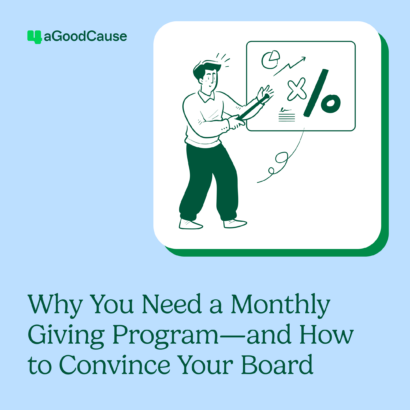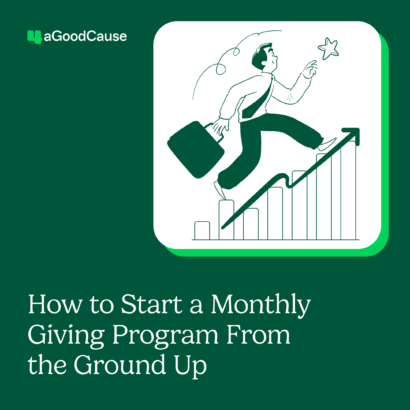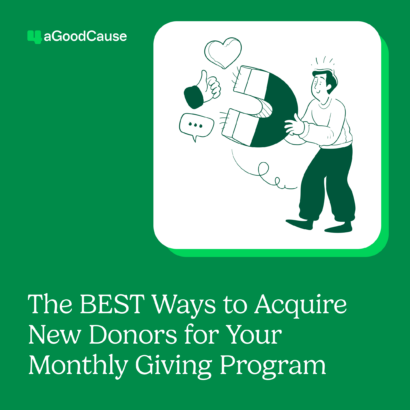While annual fund campaigns may be one of the most extensive efforts that nonprofits face, they’re also one of the most important.
Establishing an annual fund is how nonprofits cover their operational expenses while they raise money for more specific aims and projects.
Without annual funds, organizations wouldn’t be able to stay up and running to further the amazing causes they’re so passionate about!
The issue that nonprofits run into when raising money for their annual campaign, however, is that the aims of these campaigns are a little less directed.
Because the nonprofit is essentially asking donors to fund the organization instead of giving to campaigns that directly help those they serve, it can be harder to establish trust and convince donors to give.
Maybe harder, but definitely not impossible!
Here, I’ll cover 7 of the top strategies for growing your annual fund, including:
- Make relationship-building the focus.
- Establish a membership program.
- Encourage recurring giving.
- Feature multiple gift levels on your online donation form.
- Allow donors to pledge.
- Don’t forget events.
- Make a year-end appeal.
By the time we’re done, you’ll have at least a few strategies to help you optimize your annual fund campaign.
1. Make relationship-building the focus.
As all great fundraisers know, fundraising isn’t primarily about strategy; it’s about mentality.
The organizations that raise the most from their annual funds take a genuine interest in getting to know their donors and fundraise with the main goal of establishing enduring relationships with those donors.
Making relationship-building the focus of your annual fund campaign (or any fundraising campaign for that matter) will help your organization see much better results.
When donors know your organization is invested in them as individuals instead of ATMs, they’ll feel more valued. And those who feel valued will be much more likely to stick with your organization and support you for longer.
In other words, when you make your donor relationships the focus of your annual campaign, you’ll have a much higher retention rate.
Recurring donors give much more to nonprofits than one-time donors (more on that later), so you should see better results not only for your annual fund, but also for your fundraising in general.
So, what’s the best way to establish relationships with your donors? By taking a personal approach.
Taking a personal approach is exactly what it sounds like: tailoring your annual fund strategies to each individual donor.
While it will be virtually impossible to get to know your entire supporter base as well as you’d like, you can consult your donor database to help you get a better idea of your donors’ interests and preferences.
The insights you glean will help guide which type of content is most relevant to each donor and which communication channels they might prefer, so your annual fund outreach is always as compelling as possible.
The bottom line: To make the most out of your annual campaign, your organization should focus more on building meaningful relationships with donors than winning donations. Evaluate the data in your nonprofit CRM to help you start crafting personalized outreach strategies.
2. Establish a membership program.
While many donors will give out of the sheer kindness of their hearts, it can never hurt to provide an incentive.
This is especially true for annual funds, where the campaign is less targeted and it’s harder to equate donors’ gifts with concrete results.
That’s why your nonprofit should consider establishing a membership program if you don’t have one in place already.
Membership programs incentivize donors to give by offering them exclusive member status and the special perks and privileges that come with it. In exchange, the donor makes a gift to the nonprofit in the form of fees or dues.
The scope of your membership program will be entirely up to your organization and the resources that are available to you, but here are some ideas for the benefits you can offer your members:
- A package with merchandise branded to your organization.
- Exclusive perks at your fundraising events, like free food and drink.
- Access to members-only events.
- Firsthand or exclusive access to news and content from your organization.
- Internal influence at your organization.
No matter what you choose to offer, membership should spur donations to your annual fund.
Consider offering multiple membership packages priced at different levels, so that more donors will have access to your program.
The bottom line: Establishing a membership program can be an excellent way to motivate donors to give to your annual fund.
3. Encourage recurring giving.
What’s even better than a donor giving once? That same donor giving to your organization over and over and over again!
In fact, recurring givers donate about 42% more money to organizations than one-time donors.
And here’s some great news for you: your annual fund campaign is the perfect opportunity to propose recurring giving to your donors.
That’s because your annual campaign is an extended effort that will be taking place over many months, so donors will have plenty of time to give to this effort.
As you’re making your direct asks for your annual campaign, make sure to emphasize to donors how much recurring giving can make a difference for your organization. While you might not be able to directly link their gifts to specific projects, you can share how their contributions will further the needs of your organization so you can better help those you serve.
The key to turning one time donors into recurring givers is to make recurring giving as clear and convenient as possible.
Here are a couple of ways you can do that:
- Offer recurring giving as an option on your online donation form. Many of your donors will want to give online. Make it easy for them to become recurring givers by offering recurring giving as a prominent option on your donation form.
- Explicitly highlight recurring giving in your direct mail. If you’re sending out letters to make direct asks, make sure to spell out how donors can get set up with recurring giving both online and off.
Most robust online giving platforms will allow your organization to save donors’ payment information and charge them anytime a gift is set to be made (monthly, bimonthly, quarterly, etc.).
Just make sure that the donor has given you their permission and is clear on the schedule for their gifts.
The bottom line: Raise more out of your existing donor base by emphasizing recurring giving in your annual fund outreach.
4. Feature multiple gift levels on your online donation form.
Another way you can raise more from your online donation form is to feature multiple giving levels.
Providing donors with gift options can help you grow your annual fund for a couple of reasons:
- Not all donors can give equally. Your donors will want to support your annual campaign, but not all will be able to give at the same level. Featuring multiple gift options offers donors more flexibility and shows that your organization values all donations (and more importantly, all donors!), which can make donors feel more confident about giving.
- There’s a social influence factor. Many donors might be uncertain about how much they should be giving. Requesting gift sizes can make them feel more comfortable, and thus more likely to donate because they’ll know how much is “appropriate” to give.
As I’ve discussed in a previous post: you shouldn’t just randomly set giving amounts. It takes some science for this strategy to be as lucrative as possible.
The gift amounts you set should be dependent on your donors’ giving habits and your organization’s annual fund needs.
Here are a few factors you should consider when setting gift levels:
- Your campaign. What goals do you hope to achieve with your annual campaign? Keep these in mind to help you set your gift amounts in a way that’s conducive to achieving your goals.
- Average gift size. How much do your donors give on average? Average gift size can be a good starting place for setting gift amounts, but try to push it slightly higher. That way, you can ease your donors into giving at higher levels.
- Industry figures. What gift levels are other nonprofits suggesting? Your organization will want to consider other donation forms to be as competitive as possible.
With these considerations in mind, you should be able to make much more out of your online donation form.
The bottom line: Providing donors with multiple giving options on your online donation form results in them giving more. Choose your gift levels strategically to optimize your form as much as possible.
5. Allow donors to pledge.
To see the best fundraising results, you should give your donors as much flexibility over their donation experience as possible.
One of the best ways to do so is by allowing your donors to pledge.
To refresh, pledging is when a donor agrees to give a certain amount to the organization at a later date, once certain conditions have been met.
Pledges can either be time-based, meaning the donor gives once a set date rolls around, or conditional, meaning the donor gives once the organization has fulfilled the conditions set out in the pledge.
Either way you spin it, establishing a pledge program provides donors with much more flexibility when it comes to making gifts.
Many of your donors will want to contribute to your annual fund, but not all will be able to at the moment you make your direct asks. Accepting pledges will enable more donors to give, because they can give on their terms.
Think of all the donations that you might be missing out on otherwise!
Just make sure that you appoint one of your staff members to be in charge of overseeing pledges. You’ll need clearly-defined processes in place to make sure that pledges are fulfilled.
The bottom line: Pledging allows more donors to give to your organization because they’ll have more flexibility over when they can give. With a pledge program in place, your organization should see better results for your annual fund.
6. Don’t forget events.
Hosting fundraising events can be an excellent way for your organization to increase your fundraising results both now and down the line.
In fact, because they’re an excellent way for organizations to raise more, fundraising events are one of the staples of a typical annual giving campaign.
Don’t forget to include fundraising events in your annual campaign strategies, too!
Events will help you grow your annual fund in a couple of ways:
- They provide an additional opportunity to fundraise. Events are another opportunity to fundraise aside from direct asks. Many donors will feel more comfortable giving within the context of an event, because they’ll be exchanging their money for a fun experience with a community of like-minded individuals.
- They’ll help you get to know your donors. By getting to interact with your donors in person, you’ll get to know them better. You can then use the information you collect to help you optimize your campaign outreach.
- They can help donors feel more invested. Face-to-face interaction is beneficial to donors, too! Getting to meet your staff and getting involved in person can make your organization and its work more tangible to donors. They’ll feel more personally invested in your organization, which results in a more loyal and valuable base.
The type and amount of events you choose to host is up to your organization and what would best fit your donor base. While many organizations opt to hold one, big annual event year after year (say, a charity auction) others will host a range of smaller events throughout the campaign.
Just make sure that you schedule your events well in advance.
While you’ll want to leave a little flexibility to accommodate the unknown schedules of key contributors, you should have a tentative calendar in place at the beginning of the campaign. That way, you can start promoting your events early.
The bottom line: Fundraising events are more engaging to donors, and thus can help your organization increase your annual fund results.
Bonus: If you need a little guidance when it comes to planning your annual campaign fundraising events, make sure to check out this helpful resource from Booster.
7. Make a year-end appeal.
One of the biggest factors that can influence the success of your annual fund campaign is the timing of your asks.
Most organizations will find that making a year-end appeal results in the most donations.
In fact, organizations with an annual fund report that about one-third of donations are made in the month of December.
Why, you might ask? It mostly has to do with taxes. Because the end of the year also marks the end of tax season, donors have a better idea of how much money they can give to charitable causes.
Also, it probably has something to do with the fact that the end of the year is the holiday season. Many donors are inspired by the giving spirit and want to pay it forward.
Luckily, practicing this strategy is pretty straightforward. All you have to do is plan your asks for the end of the year.
Just make sure to schedule your other campaign strategies accordingly. Because direct asks will be one of the biggest efforts of your campaign, you’ll want to make them the main focus.
The bottom line: Timing will be a huge contributor to the success of your direct asks. To maximize your annual fund, it’s best to ask at the end of the year.
For more annual fund strategies, see DonorSearch’s guide.



